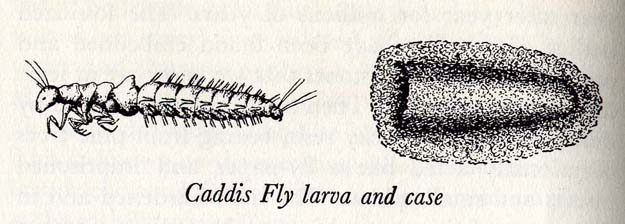Jill Norman, Down to the pond, Londres, Hutchinson, 1961, p. 42-43.
As soon as they hatch they begin to build their protective shelters. They are shy creatures and once inside only their heads and legs are visible. A sudden noise or movement will cause them to withdraw completely.
There are nearly two hundred different kinds of caddis fly in this country, yet each kind has its own favourite building material and the construction of each individual house is a work of art. Whatever may be available, the caddis fly larva always, chooses the same materials as it parent did before it, and builds its house in much the same way. The caddis fly larva cannot possibly imitate its parents because it is unlikely it has ever seen them. So how does it now what materials to choose and how to use them ? By knowledge based on instinct inherited by each generation in turn.

Some choose grains of sand to build with, sticking each grain together by a kind of cement secreted by the caddis worm. Others use small pieces of leaf, stones, pebbles or little pieces of stick, and yet another kind of house sis made of all is made by the caddis worm which sticks together whole shells. Sometimes the shells are empty, but often the caddis worm will select tiny snail shells which are still occupied, and the two animals then live together as neighbours.
Another kind of caddis fly larva will make itself a shearh using many different materials. This produces rather an untidy effect- as if it were dressed in rags and tatters. But there is one caddis worm which does not building at all ; it merely creeps inside the hollow stem of some water plant and makes its home there. No matter how rough the outside of these houses may be, the insides are always lined with the softest silk, and this is spun by the caddis worm itself.
Although they are not strong swimmers, the legs of these little animals are well developed and ther usually crawl over the bottom of the pond dragging their shelters with them. Sometimes when the house is built of stone or gravel the caddis larva may fin dit so heavy that it can hardly move it about at all.
In these illustrations you can see the adult, the larva and one of the house built by caddis fly in Britain. Some people make collections of caddis fly cases to see how many differents kinds they can find.